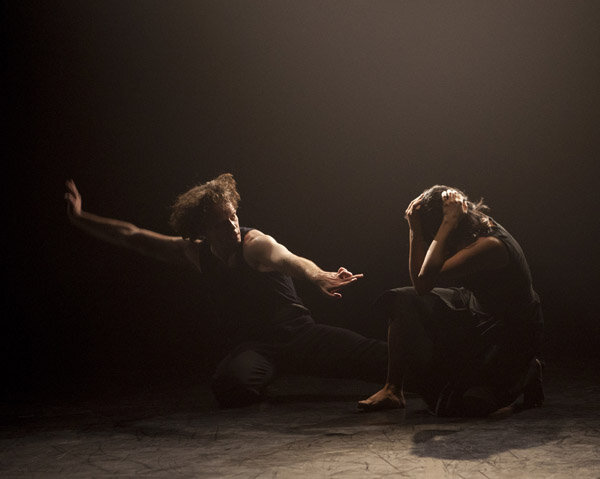Digging Deeper: একসঙ্গে / Akshongay – Longing for Catastrophic Love
Public Space Research Intern and Svāhā! cast member, Mushtari Afroz, reflects on her experiences with একসঙ্গে / Akshongay
Ten years have passed since I first saw Akshongay live at the Kalanidhi Festival in Toronto. As a young dancer at the time, I must admit that my focus was more on the corporeal than on the narrative proposition of the work. A lot has changed over the past decade— I have matured philosophically in my thinking about dance, life’s experiences have shaped me, and I have learned, and continue to learn, to embrace the many shades of love in my own life. With that added decade of life experience behind me, I now reflect on Akshongay as I observe the behind-the-scenes process during early rehearsals at NBC, where Nova Bhattacharya and Louis Laberge-Côté are preparing for its remount in Toronto for Spring 2025.
Audience members who experienced this work in the past interpreted it in different ways. Some saw it as the coming together of two dance forms—Bharatanatyam and Western Contemporary—while others viewed it as a meeting of two cultures, Bengali-Canadian and French-Canadian. For some, it was a portrayal of two people deeply in love, embarking on a journey together in life. While these interpretations are all within the awareness of the performers, what emerged from my conversations with them during my studio visit in December was what they consider to be the central focus of the remount: their interest in exploring the journey of the relationship—how the couple in Akshongay, profoundly in love with each other, moves forward in life together, one step at a time, peeling back the layers of life like an onion.
Photo by John Lauener
It may seem almost cliché to talk about such profound love in an era dominated by social media, online dating apps, and speed dating reality shows that manufacture love and offer it as a low-risk, disposable commodity. It is easy to find, easy to discard, and, in a sense, take for granted something that is sold as 'love’ in this commodified economy. As a matter of fact, every second across the globe, as countless couples utter the words 'I love you,' just as many are parting ways, symptomizing a pattern similar to the exchange of commodities in the market—a process where we commit only as long as the perceived risk is minimal. Hence, in the 21st century where superficial representations of love, disguised as passionate and true love, is so readily available, discussions of the latter may seem secondary and unimportant. Yet, I believe that is precisely why we need to engage more seriously with the concept of love in relationships. What if we viewed falling in love as a catastrophic event? And how does the life unfold for two people after that catastrophic fall?
As I listened to Bhattacharya and Laberge-Côté recount their five-year creative process leading to the premiere of Akshongay over a decade ago—a journey of deep self-reflection on their personal fantasies, challenges, and struggles within their own relationship—I couldn’t help but view the couple on stage, who emerged organically yet was infused with artistic integrity and informed by those reflections, as the embodiment of two people who have catastrophically fallen in love. This 'catastrophic love,' as Slovenian philosopher Slavoj Žižek suggests, echoing Alain Badiou, disrupts the very balance of life.1 It pulls one out of their ordinary trajectory and introduces a ‘singularity’—a rare event that unsettles their comfortable, predictable rhythm of daily life in a way that completely shatters it. The couple in Akshongay has ‘fallen’ into the abyss of this passionate catastrophe, losing control but determined to navigate the uncertainty that follows.
It is in this shared determination to walk together through the disconcerting unknown of differences, which is the essence of the Bengali word একসঙ্গে (Akshongay), that the idea of love as a quest for truth—a truth about the world that is revealed when experienced from the point of view of not one, but two—is truly realized. From simple disagreements, such as one person loving a lobster dinner on the beach while the other prefers a culinary fusion at a chef’s table, one enjoying a lavender bath while the other opts for a green apple bath, or one forgetting the other’s preferences in the daily hustle and bustle of life while the other craves that minute attention, to more significant challenges like one seeking wild adventure in life and taking a leap of faith while the other longs for more certainty— how does love create a third space in a person’s life, one that allows for the profound experience of such differences, not just as isolated incidents but on a day-to-day basis? How does it create a space for learning to trust these differences as two people commit to one another? How does it offer that third space in which two individuals ritualistically navigate these differences, constructing and reconstructing each other, moving beyond their individual planes of existence? And within that temporal dimension of rituals, how does an almost unrecognizable third entity emerge—one not bound by gender, identity, or privilege, but only by passion and trust in the face of catastrophe? I long to experience that ritualistic construction of catastrophic love in the remount of ‘একসঙ্গে/Akshongay’ in Spring 2025.
1 Slavoj Žižek, Slavoj Žižek: Love is Evil, Spreeblick, https://www.youtube.com/watch?v=hg7qdowoemoemo.
2 Alain Badiou and Nicholas Truong, In Praise of Love, trans. Peter Bush (New York: The New Press, 2012).

